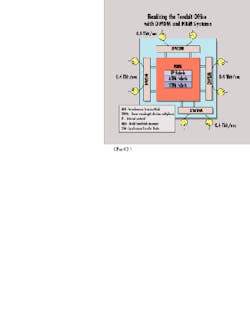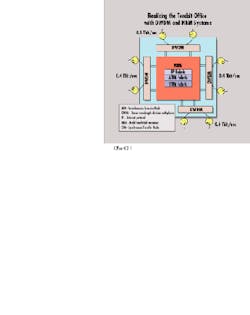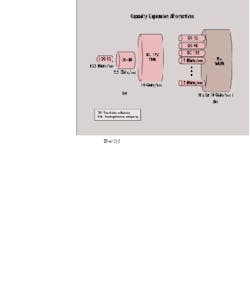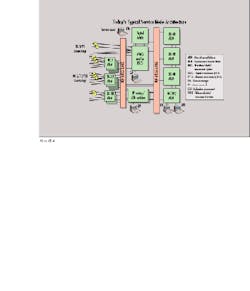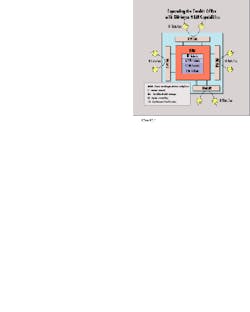Realizing the terabit central office
Realizing the terabit central office
Capacity expansion and bandwidth management are the keys to the future of networking in an increasingly competitive environment.
Steven H. Hersey and Mark R. Wilson Lucent Technologies
A ground swell of end-user demand for bandwidth-intensive services is stirring competition in the telecommunications arena. To keep pace, carriers want the most cost-effective solutions in their network to help grow their bottom line as they increase capacity and offer advanced services. At the same time, the dynamics of ever-cheaper bandwidth--or transmission cost per bit--encourage the development of applications that, in turn, will trigger even more demand for additional capacity. The result is a self-reinforcing, upward spiral in bandwidth with no end in sight.
Within public network service nodes, this bandwidth spiral is driving capacity requirements up to and beyond a terabit per second. With an eye toward protecting their network investment while staying ahead of this capacity curve, carriers require a "terabit office" solution that alleviates the need to make set predictions about their traffic growth.
While the demand for more capacity is the force behind this terabit office, efficient bandwidth management of that capacity across a broad range of services is equally crucial for service providers as they seek to expand in an increasingly competitive marketplace. Effective management of this exploding bandwidth will ensure efficient delivery of a broad range of services, optimal use of facilities across the network, and the ability to continuously upgrade the capabilities of the terabit office.
Expansion and management
There are two fundamental requirements for realizing the terabit office. First is expanding the capacity of fiber facilities, which is accomplished through the combined use of dense wavelength-division multiplexing (DWDM) and time-division multiplexing (TDM) technologies. Second is having flexible, modular bandwidth management across Internet protocol (IP), Asynchronous Transfer Mode (ATM), Synchronous Transfer Mode (STM), and optical networking layers, which is accomplished through the implementation of a multiservice platform that can be called a nodal bandwidth management system (NBM). This new NBM architecture, achieved through network element consolidation, can simultaneously reduce central office equipment costs, floor space requirements, and operations costs, and significantly improve transport reliability.
Deploying solutions that effectively manage the "one-two punch" of ever-increasing capacity demands and broader service flexibility is the key to establishing a futureproof network. With scalable bandwidth and an efficient means of routing and directing that bandwidth--regardless of traffic type--carriers can keep pace with rising competition and customer demand for advanced data services.
The terabit office is characterized by hundreds of gigabit-per-second transmission links serving multiple routes emanating from a central office (see Fig. 1). This level of capacity is only possible through the combination of high-bit-rate TDM and high-channel-count DWDM equipment.
Until recently, the methods of increasing transport bandwidth capacity were limited to adding new fiber and deploying overlay transport networks and/or increasing the TDM transmission rate--usually fourfold--of a given transport system. An illustration of this migration is given in Figure 2(a), which illustrates capacity upgrades across three prominent TDM SONET transmission rates: OC-12 (622 Mbits/sec), OC-48 (2.5 Gbits/sec), and OC-192 (10 Gbits/sec).
While TDM-based capacity upgrades do increase the available bandwidth on a given fiber, this approach is one-dimensional in that the throughput is determined solely by the TDM bit rate. Moreover, the only way to expand the transport capacity is by replacing the lower-bit-rate system with a higher-bit-rate system. Although this infrastructure change-out has been the traditional approach, the industry has recognized that TDM-only solutions cannot keep pace with the need for ever-increasing capacity. Just as the computing world has recognized parallel processing as the key to continuously increasing processing speed, telecommunications network providers have realized that DWDM is an essential technology for establishing an infrastructure capable of continuous capacity growth.
Given the growth limitations of TDM-only solutions, DWDM provides an orthogonal dimension in which to expand capacity over a fiber facility. As shown in Figure 2(b), capacity over a DWDM-based infrastructure is increased simply by adding wavelengths, which themselves are independent of the TDM bit rate. Therefore, with the TDM/DWDM combination, throughput can be increased modularly along two dimensions: TDM bit rate and DWDM channels. This combination of TDM and DWDM achieves the transport capacity needed to realize the terabit office.
Bandwidth management comes of age
Until recently, bandwidth management, much like capacity expansion, was confined to TDM-based solutions--grooming the TDM-based fiber facilities via STM crossconnect systems of various granularities. But with future network growth dominated by data services, the design of these networks is increasingly data-centric--specifically centered around IP and ATM as a means of achieving car- rier-class wide area networking.
With the addition of these IP, ATM, and optical networking layers onto an already complex STM network, all of these layers need to be organized into a logical structure that suggests which combinations of these technologies need to be used as a given service traverses the network. Such a structure has been formulated within Lucent Technologies` Bell Labs and is known as "selective layered bandwidth management" (see Fig. 3).
For a given service type, the required layers are specified by traversing the layers from the top layer (at network ingress), down through to the common optical networking layer, traversing the core transport network within the optical networking layer, and then back up through the same layers to the top layer (at network egress). The layering for a particular service type is selected so that transport costs are minimized and all service requirements (survivability, quality of service, etc.) are met.
Up until now, the only means for addressing the above multilayered bandwidth management requirements was to deploy multiple network elements such as stand-alone add/drop multiplexers (ADMs), STM-based crossconnect systems, ATM switches, and IP routers (see Fig. 4). But as networks grow, managing all of these functions as separate "boxes" is inefficient with respect to cost, reliability, and operations. These inefficiencies are unacceptable, particularly within the competitive environment existing among service providers.
The NBM reduces network costs and improves network reliability by combining IP, ATM, STM, and optical networking technologies on a single platform (see Fig. 5). A network element integrates all access and transport facilities within a network/service node and efficiently manages bandwidth between these facilities via modular scalable switching fabrics. These switching fabrics are designed to perform selective layered bandwidth management between all access and transport facilities.
Reaping the benefits
The application of the NBM architecture to the service node clearly provides several benefits to the carrier (see Fig. 6). The NBM dramatically reduces nodal equipment costs via the integration of all service node-based ADMs, STM crossconnect systems, ATM switches, and IP routers. It also reduces space requirements, again via the high degree of network element consolidation. It improves transport reliability via the elimination of all inter-element cabling within the service node. Finally, it simplifies operations (and reduces operations costs) via elimination of multiple element management system platforms. Bell Labs studies have shown equipment savings of 30% to 70% and reductions in space requirements of 70% to 85%, depending on the size of the service node. Moreover, additional Bell Labs studies have shown transport reliability improvements of 60% to 80%.
If the bandwidth contained within a given wavelength terminates within the service node, then the bandwidth is managed across the appropriate combination of fabrics consistent with the selective bandwidth management structure discussed earlier. However, if the entire wavelength is merely being interconnected, or "expressed," through the service node between two transport facilities, then the wavelength`s bandwidth can be switched between the DWDM systems via the NBM STM fabric at that wavelength`s line speed (STS-48c, for example). Of course, the STM fabric also provides an opportunity to regenerate the optical signals for these expressed wavelengths, a capability that is typically required in interconnecting express traffic through a backbone network node.
This optical line speed "expressing" application, in which electrical regeneration is performed, is known as "opaque optical crossconnection." The term "opaque" refers to the optical-electrical-optical (O-E-O) conversion that is performed within the NBM. Another term that is often used is "transparent optical crossconnection," which refers to wavelengths that are connected at optical line speed "transparently" via an optical switching fabric and thus do not undergo any electrical regeneration function. The application domains for opaque versus transparent optical line-rate crossconnection is an area of current research.
To perform transparent optical switching within the nodal bandwidth manager architecture, an optical crossconnect fabric could be added (see Fig. 7). Of course, regardless of whether a transparent (via an optical networking-layer fabric) or opaque (via an STM-layer fabric) solution is implemented, the ability to continually increase NBM interface capacity for expressing wavelengths among transport facilities is required to provide a platform for expanding the terabit office well into the future.
As high-bandwidth services become cheaper and more ubiquitous, the day will come when not only every business, but every PC and home could have its own high-speed line to the Internet. As service providers gear up for that day, the terabit office solution is the ticket for investing in networks of the future to ensure profitability and long-term growth in market share. This approach enables carriers to stay on top of the bandwidth spiral by delivering the capacity growth needed to meet customers` demands, along with the efficient management of that bandwidth to help provide a full range of services more cost-effectively. q
Steven H. Hersey and Mark R. Wilson are applications engineering managers in Lucent Technologies` Optical Networking Group at the North Andover, MA, and Holmdel, NJ, locations, respectively.Fig. 7. By adding an optical crossconnect fabric, the nodal bandwidth manager architecture enables optical switching.
